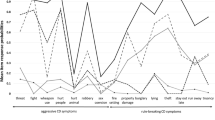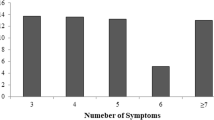Abstract
This study investigates the prevalence and subtypes of conduct disorder (CD) and behavioral problems among youth in two communities characterized by prolonged parent–child separation upon immigration. CD and problem behaviors were assessed in 252 Caribbean–Canadian and Filipino–Canadian adolescents (12–19-year-old) using the DISC-C, the YSR and the CBCL cross-informant construct. Adolescents reported less problem behaviors than their host country peers, despite immigrant background or parent–child separation. The high adolescent-onset CD rate supports the hypothesis that psychosocial stressors play a role in the emergence of the disorder. Specifically, high levels of perceived racism and low collective self-esteem predicted problem behaviors in these youngsters.
Similar content being viewed by others
References
Achenbach TM, Rescorla LA (2001) Manual for the ASEBA school-age forms & profiles. Library of Congress: Vermont
Aguilar B, Sroufe AL, Egeland B, Carlson E (2000) Distinguishing the early-onset/persistent and adolescence-onset antisocial behavior types: From birth to 16 years. Dev Psychopathol 12:109–132
Anderson WW, Grant R (1987) Patterns of adjustment of West Indian immigrant children in metropolitan Toronto schools. In University Y. (ed) The new newcomers. Canadian Scholars’ Press, Toronto
Bals M (1999) Les domestiques étrangères au Canada: Esclaves de l’espoir. L’Hartman, Montreal
Bassarath L (2001) Conduct disorder: a biopsychosocial review. Can J Psychiatry 46(7):609–616
Beiser M, Hou F, Hyman I, Tousignant M (2002) Poverty, family process, and the mental health of immigrant children in Canada. Am J Public Health 92(2):220–227
Bird HR, Canino G, Davies M, Zhang H, Ramirez R, Lahey BB (2001) Prevalence and correlates at antisocial behaviors among three ethnic groups. J Abnorm Child Psychol 29(6):465–478
Boyd CP, Gullone E, Needleman GL, Burt T (1997) The family environment scale: reliability and normative data for an adolescent sample. Fam Process 36(4):369–373
Breton J-J, Bergeron L, Valla J-P, Berthiaume C, Gaudet N, Lambert J, et al. (1999) Quebec child mental health survey: prevalence of DSM-III-R mental health disorders. J Child Psychol Psychiatry 40(3):375–384
Brown TN, Williams DR, Jackson JS, Neighbors HW, Torres M, Sellers SL, et al. (2000) “Being Black and feeling blue”: the mental health consequences of racial discrimination. Race Soc 2(2):117–131
Castro T (2001) A situation on Filipino–Canadian youth. Montreal Children’s Hospital: Montreal
Chen C, Greenberg R, Lester J, Dong Q, Guo M-S (1998) A cross-cultural study of family and peer correlates of adolescent misconduct. Dev Psychol 34(4):770–781
Collishaw S, Maughan B, Goodman R, Pickles A (2004) Time trend in adolescent mental health. J Child Pshychol Psychiatry 45(8):1350–1362
Espiritu YL, Wolf DL (2001) The paradox of assimilation. Children of Filipino–Canadian immigrants in San Diego. In: Rumbaut RG, Portes A (eds) Ethnicities: children of immigrants in America. Russell Sage Foundation, New York, pp 157–186
Fergusson DM, Lynskey MT, Horwood LJ (1996) Factors associated with continuity and changes in disruptive behavior patterns between childhood and adolescence. J Abnorm Child Psychol 24(5):533–553
Fuligni AJ (1997). The academic achievement of adolescents from immigrant families: the roles of family background, attitudes, and behavior. Child Dev 68(2):351–363
Goebert DA, BEll CK, Hishinuma ES, Nahulu LB, Johson RC, Foster J, Carlton BS, McDermott JF Jr, Chang JY, Andrade NN (2004) Influence of family adversity on school-related behavioral problems among multi-ethnic high-school students. School Psychol Int 25(2):193–206
Guarnaccia PJ, Lopez S (1998) The mental health and adjustment of immigrant and refugee children. Child Adolesc Psychiatr Clin N Am 7(3):537–553
Jensen PS, Edelbrock C (1999) Subject and interview characteristics affecting reliability of the diagnostic interview schedule for children. J Abnorm Child Psychol 27(6):413–415
Jessor R, Turbin MS, Costa FM, Dong Q, Zhang H, Wang C (2003) Adolescent problem behavior in China and the United-States: a cross-national study of psychosocial protective factors. J Res Adolesc 13(3):329–360
Kessler RC, Mickelson CK, Williams RD (1999) The prevalence, distribution, and mental health correlates of perceived discrimination in the United States. J Health Soc Behav 40(9):107–115
Lahey BB, Loeber R, Quay HC, Applegate B, Shaffer D, Waldman I, et al. (1998) Validity of DSM-IV subtypes of conduct disorders based on age of onset. Am Acad Child Adolesc Psychiatry 37(4):435–442
Lashley M (2000) The unrecognized social stressors of migration and reunification in Caribbean families. Transcult Psychiatry 37(2):201–215
Loeber R, Green SM, Lahey BB, Frick PJ, McBurnett K (2000) Findings on diruptive behavior disorders from the first decade of the developmental trends study. Clin Child Fam Psychol Rev 3(1):37–60
Luhtanen R, Crocker J (1992) A collective self-esteem scale: self-evaluation of one’s social identity. Pers Soc Psychol Bull 18:302–318
Lustig SL, Kia-Keating M, Knight Grant W, Geltman P, Ellis H, Kinzie DJ, et al. (2004) Review of child and adolsecent refugee mental health. J Am Acad Child Adolesc Psychiatry 43(1):24–36
Marmorstein NR, Iacono WG (2005) Longitudinal follow-up of adolescents with late-onset antisocial behavior: a pathological yet overlooked group. J Am Acad Child Adolesc Psychiatry 44(12):1284–1291
Maughan B, Rowe R, Messer J, Goodman R, Meltzer H (2004) Conduct disorder and oppositional defiant disorder in a national sample: developmental epidemiology. J Child Pshychol Psychiatry 45(3):609–621
McCabe K, Hough R, AWP, Yeh M (2001) Childhood and adolescent onset conduct disorder: a test of the developmental taxonomy. J Abnorm Child Psychol 29(4):305–316
McCabe K, Rodgers C, Yeh M, Hough R (2004) Gender differences in childhood onset conduct disorder. Dev Psychopathol 16:179–192
Messier C, Toupin J (1994) La clientèle multiethnique des centres de réadaptation pour les jeunes en difficulté. Commission de protection des droits de la jeunesse, Québec City
Moffit TE (1990) Juvenile delinquency and attention deficit disorder: developmental trajectories from age 3 to 15. Child Dev 61:893–910
Moffit TE, Caspi A, Dickson N, Silva P, Stanton W (1996) Childhood-onset versus adolescent-onset antisocial conduct problem in males: natural history from ages 3 to 18 years. Dev Psychopathol 8:399–424
Moos HR, Moos SB (1986) Family environment scale manual, 2nd edn. Consulting Psychologists Press: Palo Alto
Morgan C, Cauce AM (1999) Predicting DSM-III-R disorders from the youth self-report: analysis of data from a field study. J Am Acad Child Adolesc Psychiatry 38(10):1237–1245
Munroe Blum H, Boyle MH, Offord DR (1988) Single-parent families: child psychiatric disorder and school performance. J Am Acad Child Adolesc Psychiatry 27(2):214–219
Noh S, Beiser M, Hou F, Kaspar V (1999) Experiences of racism among Southeast Asian refugees in Canada. In Roth R (ed) Psychologists facing the challenge of a global culture and human rights and mental health. Pabst Science Publishers, Lengerich, pp 503–515
Noh S, Beiser M, Kaspar V, Hou F, Rummens E (1999) Perceived racial discrimination, depression and coping: a study of Southeast Asian refugees in Canada. J Health Soc Behav 40:193–207
Normandeau A, Douyon é (1995) Justices et communautés culturelles. Méridien, Montréal
Nyborg VM, Curry JF (2003) The impact of perceived racism: psychological symptoms among African American boys. J Clin Child Adolesc Psychol 32(2):258–266
Offord DR, Boyle MH, Szatmari P, Reagrant N, Links PS, Cadman DT, et al. (1987) Ontario child health study. II. Six-month prevalence of disorder and rates of service utilization. Arch Gen Psychiatry 44:832–836
Ogbu J (1993) Foreword. In: Solomon PR (ed) Black resistance in high school: forging a separatist culture. State University of New York Press, Albany
Piko BF, Fitzpatrick KM, Wright DR (2005) A risk and protective factors framework for understanding youth’s externalizing problem behavior in two different cultural settings. Eur Child Adolesc Psychiatry 14(2):95–103
Rousseau C, Drapeau A (2003) Are refugee children an at-risk group? A longitudinal study of Cambodian adolescents. J Refug Stud 16(1):67–81
Rousseau C, Drapeau A (2004) Premigration exposure to political violence among independent immigrants and its association with emotional distress. J Nerv Ment Dis 192(12):852–856
Rousseau C, Drapeau A, Platt R (2000) Living conditions and emotional profiles of young Cambodians, Central Americans and Québécois youth. Can J Psychiatry 45(10):905–911
Rousseau C, Drapeau A, Rahimi S (2003) The complexity of trauma response: a 4-year follow-up of adolescent Cambodian refugees. Child Abuse Negl 27:1277–1290
Sawyer MG, Arney FM, Baghurst PA, Clark JJ, Greatz BW, Kosky RJ, et al. (2001) The mental health of young people in Australia: key findings from the child and adolescent component of the national survey of mental health and well-being. Aust N Z J Psychiatry 35:806–814
Schaffer D, Dulcan M, et al. (1996) The NIMH diagnostic interview schedule for children version 2.3 (DISC-2.3: description, acceptability, prevalence rates, and performance in the MECA study. J Am Acad Child Adolesc Psychiatry 35:865–877
Sewell-Coker B, Hamilton-Collins J, Fein E (1985) Social work practice with West Indian immigrants. Social Casework: J Centemp Soc Work 563–568
Sewell-Coker B, Hamilton-Collins J, Matthews L (1997) In search of the American dream: the impact of immigration on West Indian Families. Trinidad
Shaffer D, Fisher P, Lucas CP, Dulcan MK, Schwab-Stone ME (2000) NIMH diagnostic interview schedule for children version IV (NIMH DISC-IV): description, differences from previous versions, and reliability of some common diagnoses. J Am Acad Child Adolesc Psychiatry 39(1):28–38
Shaffer TG (2006) An application of DSM-IV’s outline for cultural formulation: understanding conduct disorder in Latino adolescents. Agression Violent Behav 11(6):655–663
Solomon P (1993) Black resistance in high school: forging a separatist culture. State University of New York Press: Albany
Stevens GWJM, Pels T, Bengi-Arslan L, Verhulst FC, Vollebergh WAM, Crijnen AAM (2003) Parent, teacher and self-reported problem behavior in The Netherlands: comparing Moroccan immigrant with Dutch and with Turkish immigrant children and adolescents. Soc Psychiatry Psychiatr Epidemiol 38:576–585
Suárez-Orozco C (2000) Identities under siege: immigration stress and social mirroring among the children of immigrants. In: Antonius CG, Robben M, Marcelo M, Suárez-Orozco M (eds) Cultures under siege: collective violence and trauma Cambridge University Press, Cambridge, pp 194–226
Tousignant M, Habimana E, Biron C, Maol C, Sidoli-LeBlanc E, Bendris N (1999) The Quebec adolescent refugee project: psychopathology and family variables in a sample from 35 nations. J Am Acad Child Adolesc Psychiatry 38(11):1–7
Vazsonyi AT (2004) Parent-adolescent relations and problem behaviors: Hungary, the Netherlands, Switzerland, and the United States. Marriage Fam Rev 35(3–4):161–187
Weisz JR, Suwanlert S, Chaiyasit W, Weiss B, Walter BR (1987) Over and undercontrolled referral problems among children and adolescents from Thailand and the United States: the Wat and Wai of cultural differences. J Consult Clin Psychol 55(5):719–726
Zoccollilo M (1993) Gender and the development of conduc disorder. Dev Psychopathol 5:65–78
Author information
Authors and Affiliations
Corresponding author
Rights and permissions
About this article
Cite this article
Rousseau, C., Hassan, G., Measham, T. et al. Prevalence and correlates of conduct disorder and problem behavior in Caribbean and Filipino immigrant adolescents. Eur Child Adolesc Psychiatry 17, 264–273 (2008). https://doi.org/10.1007/s00787-007-0640-1
Accepted:
Published:
Issue Date:
DOI: https://doi.org/10.1007/s00787-007-0640-1




